#Rajput society
Explore tagged Tumblr posts
Text
दलित समाज पर आंच आए तो क्षत्रियों का धर्म है, हम उनके साथ खड़े होकर लड़ाई लड़ें; दुर्जन सिंह राजपूत
Bharat Band: भारत बंद के संदर्भ में आज एक प्रमुख बयान देते हुए दुर्जन सिंह राजपूत ने समाज में एकता और समानता के महत्व पर जोर दिया। उन्होंने जय भीम का उद्घोष करते हुए अपने विचार साझा किए और कहा, “जय भीम हमारा जो इस समाज है हिंदू समाज और हमारे हिंदू समाज की सबसे अहम और सबसे पहली कड़ी है वो दलित और शोषित वर्ग है।” उन्होंने आगे कहा, “इस समाज पर अगर कभी कोई आंच आती है तो हम सबका फर्ज और क्षत्रियों का…
0 notes
Text
.
#no bcs#one of the main reasons i wanna get into a college thatll let me take history as like an elective#is bc the history they teach us in school is so insanely partial and selective???#first off they cut the chapter abt mughal kings from our book#grabted they kept the one abt mughal rural society but still?? u can't rlly defend them cutting this MAJOR portion out#nd then theres the stuff they don't have in the books at all#like i vaguely recall studying abt cholas in 6th grade maybe?? or seventh???#but even my teachers didn't take hist as a subject seriously back then and i was least bothered abt school so i didn't pay attention#ig thats partially my fault but also..idk i feel like our teachers should've done more to get us interested.#anyway so the cholas we did SIX years ago#and we learnt nothing abt the other tamil cheifdoms except Vijaynagara#the hyper focus on norht India aside#they also just did not teach us abt the rajput kingdoms either?? between the mughals and the british#we learned NOTHING abt those rulers#like ? ur content is already missing so much WHY would u exclude even more instead of introducing more stuff ???#insane!!#anyway i know better than to rely on fkin ncert for my historical knowledge lmao
1 note
·
View note
Text
Nodal Dominant Themes — 𝐍𝐚𝐤𝐬𝐡𝐚𝐭𝐫𝐚 𝐎𝐛𝐬𝐞𝐫𝐯𝐚𝐭𝐢𝐨𝐧 𝐒𝐞𝐫𝐢𝐞𝐬 (part 1) 𝐨𝐟 𝐩𝐚𝐫𝐭 𝟓
Ardra, Swati, Shatabhisha embody Rahu qualities to the fullest. Breaking boundaries, whether they mean to or not, refining or rebuilding themselves by the way they absorb Maya (illusion), being thrown into foreign lands to create, explore and challenge existing paradigms. The ultimate mastery of Rahu nakshatras lies in recognizing that Maya is not the goal, but the process of refinement. This is shown in the natives' urge to learn, apply and cultivate something for themselves. This means that their initial stages have a lot of lack, and that's where that hunger to achieve and receive comes from. They'll take on challenges if it means there's an opportunity to fulfill themselves. In these following examples, the Rahuvian character is often given an opportunity to enter higher societies, usually through a job, a scholarship or from meeting the right person in the right time.

Swati Sun Julia Roberts, in Pretty Woman, plays a poor, sex worker who enters the high society through a billionaire and becomes 'refined'. Despite her glow up, her authenticity still contrasts with the pretentiousness of the high class social circle she finds herself in, challenging their perceptions of worth and class.
Much like Pretty Woman, in the film My Fair Lady, the Rahuvian meets a snobbish phonetics professor who wages that he can make her presentable in high society.


In the film Khoobsurat, Shatabhisha Moon Sonam Kapoor Ahuja plays a quirky physiotherapist who is ill-mannered and boundless. She is given a once-in-a-lifetime opportunity to work for a royal family. There, she meets a handsome young Rajput prince who is her complete opposite (given that he is portrayed by a Mula Moon native, Fawad Khan, who adheres to the customs of his background, bound by his roots).

Despite their different social classes, the royal family learns a lot from her authenticity.
This theme of outer duality in which the native crosses over to a whole new world different from where they originally came from centers a lot around the 'poor vs rich' dynamic in these modern examples — exploring classism, elitism and other societal divisions which make outsiders.

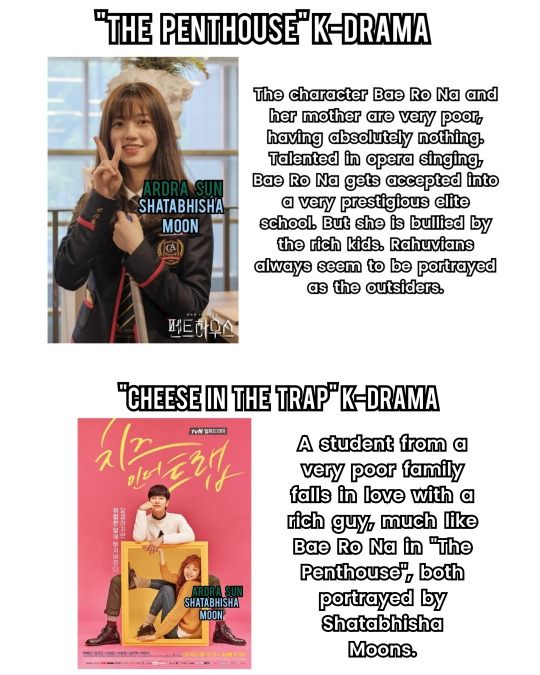
As I briefly gave examples in this post, Shatabhisha can be linked to Cinderella. Which means that trine nakshatras can also inherit this theme of person from poor background falls in love with person from wealthy background. As shown in that post, the union is often with a Mula native. It was expected to find these Rahu-Ketu connections, as the nodes are always one with each other. Their themes can overlap, which I'll be going more into further down this post.

The Mula CEO also comes from old money.
Rahu thrives on venturing the unknown and embracing the unconventional, often shown in the trope of one falling in love with someone alien.
This otherworldly love is seen in Pirates of the Caribbean: On Stranger Tides, where a Rahuvian sailor falls in love with the mermaid, Syrena. Mermaids are captured and exploited by humans — immediately we see this theme of division. And unlike the other humans, he treats Syrena with respect and equality.

Syrena is portrayed by Mula Moon Astrid Berges-Frisbey, while the sailor is portrayed by Ardra Sun Sam Claflin. In the end, Philip becomes a merman and lives with Syrena underwater. This transformation that the Rahuvian goes through in order to unite with a lover of another species is also seen in the film Lisa Frankenstein, starring Shatabhisha Moon Kathryn Newton — although it's more in a Romeo-&-Juliet style.

The Rahuvian character, Lisa, falls in love with Creature, who is a living corpse portrayed by Magha ASC Cole Sprouse. Lisa kills herself in a tanning bed to join the Creature in death. Their union shows her alive, but mummified.
This theme of one overcoming the obstacle between them and the person they desire is seen yet again in the film Casper (1995). A girl, played by Magha ASC Christina Ricci, meets a ghost named Casper, who falls in love with her. Casper is voiced by Malachi Pearson who has potential Swati Moon. Casper's one wish is to be human again so that he can win her heart.

His wish is fulfilled but he can only be human up until midnight. His human form is portrayed by Swati Moon Devon Sawa.
In the Korean drama, Are You Human?, Shatabhisha Sun Gong Seung-yeon plays a bodyguard who is given an opportunity to protect an advanced humanoid whom she falls in love with. Another abnormal, interspecies relationship.

The humanoid is the clone of an heir of a rich conglomerate. The heir is portrayed by Magha Moon native Seo Kang-joon – him being born into wealth contrasts with her being brought up from a poorer background; we see this theme again of a cross over between two opposite worlds as she gets romantically entangled with him.
A lot of these pairings show Rahu's need to break taboos and seek authenticity over conformity, as these unions tend to be abnormal in a discriminatory society. As illusory as Rahu is by nature, it highlights the illusions within society and the challenges that come with it.

Rahu seeks to challenge conventions, forcing individuals to confront their biases, embrace diversity, and explore love in its most expansive ways; while Ketu can be detached from society in general, already transcending or dissociating from it altogether.
Now extending the old money archetype into this, we can see Rahuvians embodying this shabby, nonconforming, rough-around-the-edges, transformative archetype who'll be on the opposite end. As Ketu symbolizes the past, ancestral roots, tradition, the old way of doing things; Rahu symbolizes the future, foreignness, pursuit, a new way of doing things.
Old money often means adhering to strict family rituals, customs, and expectations. There's an expectation for the wealthy to marry their own, maintaining a cultural practice that has existed for centuries, a theme of Ketu as it means to preserve the past. But Rahu comes in as a disruptor, changing rules that seemed absolute, causing more confusion and tension. Rahu often seeks unity, even with our all differences.

Rahu and Ketu are always 180 degrees apart in a chart. This gives an understanding to how they're always on opposite sides of the same coin. So their union in these media examples often come with resistance and chaos.
The story of Romeo and Juliet is about a star-crossed love stuck in this push-&-pull between tradition and breaking free from tradition.

Rahu is symbolized as the head of a dragon, while Ketu is the tail. Together they remain in this endless chase, their nature defined by longing and separation. Maria and Tony from A West Side Story mirrors this nodal dynamic, as it's based on the classic Romeo and Juliet. Just as the nodes themselves are forever trapped in opposition and in an eternal chase, these lovers remain trapped by their differences. Their love and lives are destined to be cut short, signifying the impossible union between the opposing nodes in these forbidden love stories.

The tragic ending of Maria and Tony’s story reflects the inevitable nature of the nodes. In both Romeo and Juliet and A West Side Story, we see the power of love transcending societal barriers, yet this love is doomed by the very forces it seeks to overcome.


Ashwini nakshatra literally has the strongest ties in Romeo & Juliet (list).
Another pair of this nodal influence (Ketu-Ketu), with this exact theme, is Mavis and Johnny from the animation Hotel Transylvania. Mavis is voiced by Ashwini Moon Selena Gomez, and Johnny is voiced by Magha Sun Andy Samberg. Mavis is a vampire and Johnny is a human. Their worlds should never have had a crossover to begin with. But Johnny, being Magha, feels a sense of belonging with these monsters and Mavis instead of fearing them (a nod to the Mula archetype and Beauty-&-the-Beast trope, which, as I've stated before, can also manifest itself as Ketu-Ketu instead of Ketu-Jupiter... much like Belle and Rumpelstiltskin from Once Upon A Time, Belle being played by Mula Sun Emilie de Ravin and Rumpelstiltskin portrayed by Ashwini Sun Robert Carlyle — the show's own Beauty & the Beast).

Though light-hearted and comedic, their union was forbidden as monsters and humans should be kept apart to their own worlds due to past conflicts. Mavis' father, Dracula, goes to great lengths to separate the two, but then he realizes that their love is genuine and overcomes his prejudices.

The theme of letting go touches on Ketu's tendency to sever ties, signifying the lesson of how temporary things are, including love. The film Untamed Heart is a great example, perfectly encapsulating this theme between two Ketu natives.


And as Mars also rules Ashwini nakshatra, this can be a major focus.
Connecting Orpheus to Ashwini, so much of this nakshatra's themes are highlighted in this Greek myth. Ketu is associated with nature, animal caretaking, and taming wild beasts. This is seen in Orpheus's ability to charm animals, move trees and rocks, and even change the course of rivers, through his music. Music has been known as a form of comfort and healing, and Orpheus' music is so powerful that it hypnotizes wild beasts, even influencing Hades, the ruler of the underworld.

The mythological character loses the love of this life, Eurydice, and he is unable to accept her death. He becomes so desperate, filled with grief and fear, that he descends into the underworld to get Eurydice back. As Ashwini can be driven by selfishness, severance becomes a major lesson in their journey.
The musical film Black Orpheus (1959) is directed by Ashwini Sun, Magha ASC Marcel Camus, a black Brazilian retelling of the tale.

In Jason & the Argonauts (2000), Ashwini Moon Adrian Lester portrays Orpheus. In the animation Hell and Back, *Ashwini Moon Danny McBride voices Orpheus. In 1960s The Giants of Thessaly, Massimo Girotti portrays Orpheus and he has Moon in Magha (trine nakshatra to Ashwini). This obvious connection of Ashwini to Orpheus takes me back to the ruling deities, the Ashwini Kumaras. Ashwini can be related to partnership, soulmates, connected minds. Here, there's a theme of inseparability yet the nature of the nakshatra forces severance. Back to the tale — With just the charm of his music, Orpheus is able to convince Hades to bring Eurydice back to life, only under the condition that Orpheus never looks back at her when they leave the underworld. Overwhelmed with so much love, he's unable to help himself, as he fails and looks back at her as they neared the exit. This is how Orpheus loses Eurydice forever.
Similar to Orpheus, the Twelfth Doctor from Doctor Who spirals into madness and desperation after the death of his close companion, Clara Oswald. The Twelfth Doctor is played by Ashwini Sun native Peter Capaldi. His Aries relentlessness and selfishness has him breaking the laws of time to bring her back, just like Orpheus breaks the natural order of life to get Eurydice back.
Clara Oswald is interestingly nodal herself, being played by Ashwini native Jenna Coleman.
YouTube video link
His journey through grief and his refusal to let her go mirrors Orpheus's determination to challenge the natural order of life for love. In the end, Twelve's memories of Clara get wiped out when he is forced to sever ties with her. Clara remains dead and so does Eurydice. This makes these pairs star-crossed, as Ketu reminds us of the inevitability of loss and separation. With Mars there, it makes it an obvious theme with Ashwini nakshatra.

Orpheus tried to get Eurydice back after her death by seeking the realm of the dead as a mortal being. He finds the cave that led to Hades and slowly descended into the Underworld. He sang to Cerberus, a terrifying, three-headed monstrous watchdog, able to tame and charm the beast so that he enters. This theme of entering portals to other worlds and dimensions tends to be associated with Ketu, and I find it interesting that I am particularly seeing the magic within Ashwini nakshatra.


In the 2008 film Jumper, Ashwini Sun Hayden Christensen plays a young man who can teleport himself anywhere and everywhere due to a genetic anomaly.
It is interesting that Ketu nakshatras also have this otherworldliness quality to them which is seen in having access to portals or dissociating into other realms. Although I have already explored this theme within the context of Anuradha nakshatra, there is still an undeniable nodal influence to it as I see these nakshatras frequently pop up in this genre of film.

Magha Sun Amy Adams' character in Enchanted falls into a well which is a portal to another world. In Alice in Wonderland (2010), Magha Moon and Swati Sun native Mia Wasikowska's character also falls into a portal to another world.

In the animation Caroline, Ashwini ASC and Shatabhisha Sun native Dakota Fanning voices a girl who finds a portal to another world. In 1953's Peter Pan, Ardra Sun Kathryn Beaumont voices Wendy who is taken to another magical world called Neverland by a boy named Peter Pan who's voiced by Shatabhisha Sun Bobby Driscoll. In 2003's Peter Pan live-action movie, Wendy is played by Ardra Moon Rachel Hurd-Wood, taken into this whole other reality of magic and wonder. In Hook (1991), adult Peter Pan is portrayed by Shatabhisha Moon and Swati ASC Robert Williams, the character a middle-aged lawyer from the modern world who returns to his magical origins. In the Korean drama Spice Up Our Love, Ashwini Moon Han Ji-hyun's character wakes up as the protagonist of the web novel she wrote. In the Korean drama W: Two Worlds Apart, Shatabhisha Sun Han Hyo-Joo gets sucked into a webtoon written by her father. There she falls in love with the protagonist who is played by Shatabhisha Moon Lee Jong-Suk, who gets gets sucked into her reality as well. In the Chinese drama Love Game in Eastern Fantasy, Mula Sun Esther Yu gets sucked into a video game novel as a supporting character. In The Wizard of Oz, Mula Moon and Ardra ASC Judy Garland plays a Kansas farm girl who is taken away in a tornado and ends up in the magical Land of Oz. In the series Emerald City, Ashwini Sun Adria Arjona is a Kansas nurse who is transported by a tornado to the Land of Oz. In the film Oz: The Great & Powerful, Ashwini Sun James Franco is a magician who is hurled away from Kansas into the wonderful land of Oz. In the 2013 animation Epic, Magha Moon Amanda Seyfried voices a young girl who finds herself transported into an alternate world and even falls in love with Ashwini Moon Josh Hutcherson's character (I highly recommend this film).
As Rahu is associated with illusions and exploring the foreign, we see this theme of escaping into simulations and dreamy worlds which one becomes absorbed in. This has been explored deeper within Swati nakshatra, which combines the arts and illusory tendencies of Rahu together.
The influence of the nodes often transcends the physical realm, embodying forces of spirituality, illusion and transformation together. But they both manifest differently in this theme. Rahu becomes absorbed in illusions (in form of the arts, simulations, imagination (ex. Peter Pan being the boy who is attached to Neverland because he never grows up — Neverland is an illusory place only found in the minds of children, this highlighting his attachment to illusions)); while Ketu tends to escape the material plane altogether, yearning transcendence and passing by realms to seek meaning and lessons.
In the film Meet Joe Black, Mula Sun Brad Pitt plays an otherworldly being who takes over the body of a man to experience Earth and be guided in the teachings & meaning of life. His very existence quite literally transcends time and space, which I relate to Ketu, as he is a mystery himself.

He is innately detached from human concerns like time, societal expectations, and permanence. But he falls in love with a human named Susan, who is also nodal-ruled, and his nature makes their connection doomed from the start. Susan is played by Mula Sun, Mula Moon native Claire Forlani. This making for another star-crossed pair because he can never fully participate in human life.
Going into the body-swapping trope, this calls to Rahu's desire to navigate a foreign perspective while Ketu seeks to transcend its rigid reality.

In the film Hot Chick (2002), Swati ASC Rachel McAdams plays a teenage girl who wakes up in the body of a 30-year-old male criminal played by Swati Sun and Ashwini Moon native Rob Schneider. In 1989's film Dream a Little Dream, an accident puts the consciousness of an elderly dream researcher played by Magha Moon Jason Robards into the body of a bratty teenager who is played by Mula Sun and Shatabhisha Moon native Corey Haim. Many more examples often include a Saturn nakshatra native as well, which I found very interesting. Hopefully I'll be circling back to that one day!
Rahu is thriving on the chaos of this trope since an entirely new identity is being explored (and lessons are learned as the social difference in one's gender, class, and even age tends to be highlighted for the ignorant one (Rahu essentially refining the native through this experience)).
The interaction of the nodes drive each other to a deeper understanding of life's illusions as it signifies letting go and refining oneself. In this little exploration, I got to understand that Ashwini is a romantic nakshatra which deals with loss and forced detachment due to Ketu. While Rahu nakshatras tend to be more romantic and igniting conflict in their pursuit of a love that's not right according to societal standards. This solidifies the image of the eternal chase of the dragon representing desire and detachment.
#ketu#rahu#nodes#mula#shatabhisha#magha#ardra#ashwini#swati#sagitarrius#gemini#libra#leo#aries#aquarius#vedic astrology#vedic observations#sidereal astrology#sidereal observations#astrology#astro notes#astro observations#nakshatra series
378 notes
·
View notes
Text
I started writing this like over a year ago,, take this for what it is lol
~~This au takes place in the same universe as Dhriti and Jimena’s og world, but about 200 years earlier when giant and human society was beginning to reunite after a few generations of separation. Giant and human cultures grew and developed together until resource sharing became a greater struggle as commerce moved to include symbolic currency over simple trade. Now, as a way to unite wealth and land along with it, interspecies marriage has been a favored solution.~~
The air inside the carriage grew more unpleasant as the sun’s light worked to completely toast the glass that separated Jimena from the pastures she would soon inherit.
The bride-to-be was a bit shaken upon entering the home of her in-laws. Elegant, sweeping arches lined with tiles rose upward farther than she’d like to picture. Jerking her neck up awkwardly, she found herself trying to count the tiles, snapping back to attention at the feeling of a deep rumbling beneath the floor.
A woman. Wrinkled and gray, she stalked across the floor, face stony as she faced Jimena and her mother.
“Mrs. Flores.” The great woman rumbled as she bowed her head.
Though she barely reached halfway up this woman’s calf, Jimena’s mother returned the gesture, “Mrs. Rajput.” she said, bowing down but adding a small curtsy for good measure.
The gray woman turned her gaze towards her would-be daughter and again nodded with a kind of reverence that Jimena attempted to return.
“If you ladies would follow me, there are a few matters I’d like to discuss before anything is official” Mrs. Rajput’s tone was cool and demanded attention, though it could be her large presence that aroused such a feeling.
Dhriti had seldom considered marriage. They had assumed their siblings' unions would be enough to help the family maintain their legacy, but that was now proving to be false. A human woman was to be made a bride for the daydreamer. They paced about the room, anxious to meet the little baker’s daughter.
Dhriti was a damn fool.
The rumble of their steps accompanied by the clack of their cane could be felt from at least a quarter of a mile away, and could be heard possibly farther. Jimena felt Dhriti long before she laid eyes on them, following diligently behind her soon to be mother-in-law. Heartbeat flooding her ears, she was soothed momentarily by a quick squeeze of her mothers hand.
Mrs. Rajput opened a door thrice as wide as she and called out to her child, “I’m glad you’re eager.”
Dhriti froze in place before straightening out, stiff as a board, perfect posture.
Mrs. Flores led the charge, walking coolly into the room, nodding to Dhriti as she spoke “I’m delighted to meet you, Dhriti.”
Dhriti, trembling over their words, spoke, “The pleasure is all mine, Mrs. Flores.”
Looking satisfied, Jimena’s mother turned to look back at the door to find Mrs. Rajput still holding it open. Her eyes stayed fixed on Jimena, expectantly, almost hopefully. Jimena was still fastened to her place on the stone floor, gawking into the room with wide eyes, not able to see Dhriti from behind the door.
“I’m excited for you to meet my daughter, Jimena.” She said as she extended her hand, leaving Jimena to unceremoniously march into the room and take her mother’s grasp like a toddler. Jimena’s gaze stayed stuck to the floor though she held her head up high. Once at her mother’s side, Mrs. Rajput entered the room and there the four were, silent.
Jimena’s eyes were quickly tempted to find Dhriti’s boots. Then their legs, and so on, until her eyes planted firmly upon their bespectacled face. A narrow face that held a large curved nose and heavy-lidded eyes. Their lips were pursed, eyes on the floor.
They shifted, causing their wooden cane to creak before murmuring, “Hello, Jimena.”
Belly flooded with butterflies, Jimena replied.
“Hello, Dhriti.”
The giant swallowed hard, trying to will their breaths to be as silent as the humans were.
Jimena’s hold on her mother’s hand tightened just as Mrs. Flores pulled away, leaving Jimena without a lifeline. Her fingers fell into balled fists at her hip, squeezing the fear away as she stood there, feeling like a weed that had sprouted up from the tile. She opened her mouth to say something, trying to focus on anything other than Dhriti’s owlish stare. The bride shut her mouth right back up at the slightest movement of her fiance. It was too much. All too much, all at once. She shot her mother a look, an unmistakable cry for help.
As much as she wanted to save her daughter, to swaddle her in linens and force her back into the carriage bound for home, Mrs. Flores knew full well what this commitment would earn.
“Your mother tells me you’re fond of aviculture?” Mrs. Flores asks without addressing her soon to be son, perhaps a bit too loudly.
“Yes- I mean, yes ma’am…” The groom barks, rumbling the air. “Quite fond.” Remarks the hostess.
“My Jimena just adores pigeons, don’t you love?” The matron looks pointedly at Jimena, urging her to speak in a way only a mother could.
“I do…” She murmurs, face aimed at Dhriti, though her gaze is pointed at a spot on the wall, far off the ground and behind the groom’s head.
“I’m sorry?” Calls Matron Rajput. “I said I-I do, ma’am…” Her face burns. A horrid silence fills the room, all but the heavy breaths of the groom as they gawk, helplessly pinned by the small woman’s gaze. A heartbeat, then another, and another, the time between each feeling like an entire day.
Dhriti looks to their mother, closest to the door, almost like a warden as she dares her child to try and weasel away.
To the bride and her mother, the home was a great fortress, but to those who took permanent residence, it was a particularly claustrophobic space. Especially now. The tension could be sliced and served on a plate.
“Jimena,” Mrs. Rajput bravely shattered the quiet, “would you care to tour our dovecote? We’ve just had a few of our little ones lay for the first time…” Though her tongue stayed as calm and smooth as ever, though something bubbling beneath her cool veneer betrayed some desperation, an eagerness to end whatever hell this was.
Jimena turned to face her hostess, unsure of her own wants as she nodded, ever polite. “Go on then, Dhriti.” She smiled politely, tensely.
Seemingly smacked back to Earth, Dhriti frowned at their mother. “Now?”
“Yes. Now.” She spat, “Mrs. Flores and I have things to discuss, horrid, technical things that will spoil all the fun of marriage.”
Now it was Mrs. Rajput’s turn to squirm, shooting the baker’s wife a look. “Go on,” Mrs. Flores nodded, “we’ll be here.”
Jimena looked between the mothers in disbelief, though her face portrayed nothing, only her eyes were blown. At her mother’s more insistent nod, she finally took a step towards the groom, eyes only finding tile once more.
Like a golem suddenly brought to life, Dhriti jerked away from Jimena, almost like jumping from a spider. Jimena flinched the slightest bit, but continued the pursuit. With the creak of a cane, Dhriti wordlessly opened an exterior door and waited for the tiny bride to inch across its threshold.
With one final frightened look to their mother, the door closes.
Both mothers sigh in relief.
10 notes
·
View notes
Text
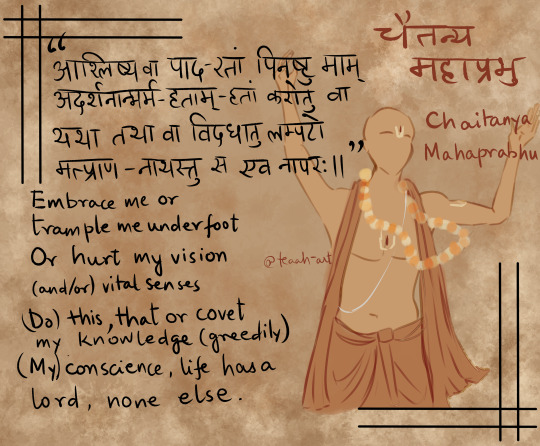
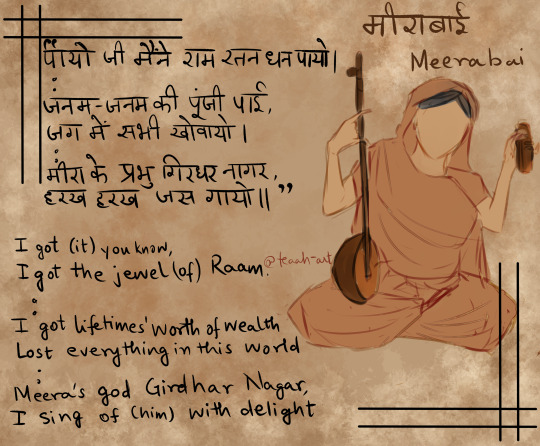
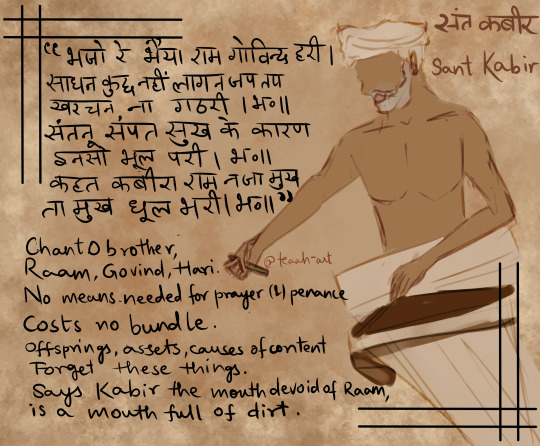
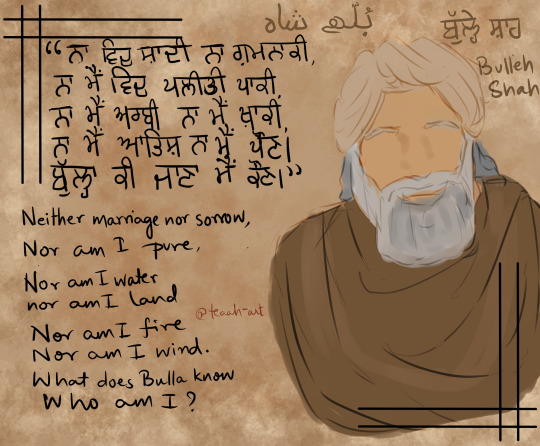
Desi LGBT Fest 2023 (hosted by @desi-lgbt-fest)
Day 7 : Faith/Rituals of Love
Definitely geared heavily towards the 'Faith' part of this prompt as soon as I read it!
If being Queer is defying conventions and if being a part of the Queer community means going against heteronormativity and gender conformity, is it not Queer to forego materialistic ties and the love of a human partner and embrace the love of a greater being you have only heard about in stories?
All four individuals featured here were integral part of the Bhakti Movement and/or Sufism in South Asia. None were married other than Meerabai.
(Panel order from top to bottom)
Chaitanya Mahaprabhu (1486-1534) : A key name of the Bhakti Movement and the Gauriya Vaishnav tradition in 15th Century Bengal, Chaitanya Mahaprabhu was believed to have been a vessel for both Radha and Krishna. Bengali doesn't use pronouns or gendered language and we may never know what they would have preferred to be identified as in a language they didn't know (English), I will simply resort to using They/Them for them. Their written teachings are few and far between but the verse mentioned here is the seventh verse of the only written record of their teachings, the Shikshastakam - a collection of 8 total verses. The translation here is my own and quite literal so that the interpretation is left to the reader.
Meerabai (1498-1597) : [CW : IMPLIED QUEERPHOBIA/APHOBIA] Meerabai was born into Rajput royalty and was married off, also to Rajput royalty, in likely an arranged marriage. While most of the stories surrounding her are folklore whose historicity is yet to be confirmed, her marital status can be confirmed, and so can her devotion and affection for Krishna and the divine, which she has herself penned in numerous poems and songs. Folklore does strongly imply that she was non-committal to her marriage and that her in-laws tried to poison her to death multiple times for it.
Kabir (1398–1448 or 1440–1518) : Found as an orphan by a Muslim weaver couple, Kabir's religion grew to become somewhat of an enigma for future generations. His stance, however, on the topic romance and marital relationships is quite clear - he looked down upon them and a huge chunk of his couplets strongly imply that romantic and sexual relations simply obstruct spiritual enlightenment.
Bulleh Shah (1680-1757) : Bulleh Shah, though an ardent proponent of loving the divine, was declared a Kafir, a non-believer/non-Muslim by a quite a few Muslim clerics of the time. He was known for speaking up against existing power hierarchies of the time and used vernacular speech for his writings (Punjabi, Sindhi) which not only served to popularize his works, but also let people connect to his words.
A personal note on my motivations under the cut.
A while back when I was actively going through the anxiety of finding out that I am ace and that I will never fit into the current South Asian society that the wedding industry has a chokehold on, I desperately wanted to see people from my own culture living happily without a partner. During one of my history rabbit hole escapedes, I restumbled upon the story of Meerabai, how she always insisted on loving and devoting herself towards Krishna, despite being married into a normative and wealthy household and despite her in-laws repeatedly attempting to poison her for not committing to her husband. Most of us from India grow up hearing about Meerabai, her spiritual connections to Krishna, and her struggles. The moral of those stories is always framed as 'believe in god, he will help you through tough times'. But this was the first time I was making a different connection, I was drawing different morals. And when I took Meerabai's non-conformity to her married life and started looking for more examples like hers, I was overwhelmed by how many more individuals existed without a partner, condemned being in a normative, married relationship, admitted to having lost human connections and faced resistance even, and yet stayed true to their orientation and sounded HAPPY! It was extremely hard to narrow it down to these four, but these do make my point! Labels are hard to transpose across cultures and history. But if being queer means being nonconforming of marital structures and being aspec/arospec implies neutrality, indifference, or aversion to romance and intercourse, then no one fits the label if they don't.
#desilgbtfest23#desi lgbt#desi lgbtq fest#long post#pride 2023#pride#original art#my art#meerabai#meera bai#sant kabir#kabir#kabirdas#bullehshah#bulleh shah#chaitanya mahaprabhu#bhakti movement#sufism#sufi#tw implied aphobia#tw mild aphobia#tw implied homophobia#btw if someone notices errors in my Shahmukhi or Gurumukhi on the Bulleh Shah illustration pls let me know#I do not speark or read or write Punjabi and I copied
105 notes
·
View notes
Text
The 13th Anniversary Arshi Fiesta
Moodboard : Historical AU
Whispers of the heart | Chapter 22

DISCLAIMER: The story is set in the early 20th century. While I have made efforts to capture the essence of the era, there may be inaccuracies as this is a work of fantasy. I do not own the characters Arnav and Khushi, and this story is purely fictional with no relation to any real individuals, living or dead. Any resemblance to actual persons or events is purely coincidental.
WARNING: 18+, MATURE CONTENT (Trigger warning-mention of r*pe and murder)



Chapter 22
"You know who I am, right?" Arnav asked softly to the little girl hunched down in her bed, clutching her knees to her chest. Her mother had died in the early morning, leaving 11-year-old Amelia in the hands of a complete stranger. Arnav saw the little girl bobbing her head slowly.
"This is my wife, Khushi," he said, drawing Khushi close and clutching her hand tightly. "We are going to take care of you, okay?" Arnav said, trying to sound reassuring. The girl raised her head to look at her brother."I know it's going to be very hard for you. but we are here for you, Amelia"
"Amy," she said softly. When Arnav looked at her questioningly, almost missing her remark, she added in her sweet trembling voice, "Only people call me Amelia when they're angry."
"Okay."
On the last Monday before they were scheduled to leave for India, Natalia passed away as her condition deteriorated considerably. Although Arnav had made arrangements for Amelia to be escorted safely to India by a friend in the event of her mother's death, but it was better that they were bringing her to India with them.
After Arnav decided to adopt Amelia and take care of her himself, he and Khushi discussed the details of bringing Amelia into their home. They decided to keep Amelia's parentage a secret from society, as growing up in a foreign society would be challenging enough for her. They didn't want to burden little Amelia even more. They would only reveal her parentage to close family members, such as the Rajputs and Anjali. Arnav did not want to lie to Anjali.
Her heart broke for the little girl as Khushi watched Arnav gently guide Amelia into their home in Delhi. Amelia's eyes were wide with a mix of fear and curiosity. The sight of Amelia's small, trembling hands clutching her frock stirred something deep within Khushi. The shadows of loss and uncertainty in Amelia's gaze mirrored the ones Khushi herself had once known all too well.
Amelia clung to Arnav's hand, her steps hesitant. Arnav's calm and reassuring voice broke through her reverie. "Khushi, why don't you show Amy her room?"
Khushi nodded, extending her hand to Amelia with a warm smile. "Come with me, Amy. Let's get you settled."
They reached the small, sunlit room Khushi had asked Gauri Ji to prepare for Amelia. "This is your room, Amy," Khushi said gently, leading the girl to the bed. "You can decorate it as you like. We'll go to the market tomorrow to buy some things, okay?"
She watched as the little girl looked around with a lost expression and nodded slowly. After a few moments, Khushi introduced Gauri Ji to Amelia. "This is Gauri Ji. She'll be with you all the time."
"Hello, Amy ji," Gauri Ji greeted Amelia awkwardly and in return, she received a forced smile from Amelia.
Together, they unpacked Amelia's few belongings. That evening, they were invited by the Rajputs for dinner. Arnav and Khushi decided to reveal the truth about Amelia that night. Khushi prayed for everything to go smoothly, but things did not turn out as hoped. As soon as Anjali learned about Amelia, she got up and locked herself in her room.
Arnav tried for several minutes to get her to open the door, but she did not respond. After much persuasion, she finally opened the door and went straight to her bed, sitting down with her back to Arnav. With a deep sigh, Arnav sat beside her.
After a long silence between the siblings, she said in a soft voice, tears evident in her tone, "How could you do that, Bhai? How could you betray Mamma like that?"
"It's not about betraying Mamma, Anjali. The girl had nothing to do with whatever happened between our parents."
"But why do you have to bring her here to remind us of that horrible incident for the rest of our lives?"
"She had no living relative except us. Imagine if Mamaji and Mahindar Chachu didn't help us when Mamma died. " Arnav said, looking down at his folded hands. "Hume sab kuch bhulake aage badhna chahiye."
"You can take care of her all you want, but please don't expect me to accept her anytime soon."
"You don't have to."
The siblings sat there silently, thinking and reflecting on their lives. "You know, I am so jealous of her right now," Anjali finally said.
"Why?"
"When I was young, I missed you so much. I always wished you didn't have to go to boarding school so I could have more time with you," Anjali said, lost in memory. "Now, she will have you with her all the time, time that I didn't have." She ended with a melancholy tone.
Arnav turned her around and hugged her shoulder sideways, and she rested her head on his shoulder. "You will always be my little sister, Anjali, even if I got a hundred others. I'm sorry I wasn't always there for you."
Meanwhile, Khushi took Amelia to her childhood room. Little Amelia was on the verge of crying.
"What happened, Amy?" Khushi asked, kneeling in front of Amelia as she sat on the bed. "Why are you crying?"
"I am causing problems, ain't I? Are you going to send me back?"
"Oh, sweetheart, no," Khushi tried to reassure the little girl. "We are a family now. We will take care of you always."
Khushi took a deep breath and started again. "Anjali Bhabhi didn't know about you earlier. That's why she's sad. Arnav is talking to her. Everything will be alright," she reassured Amelia, squeezing her small hand.
Then to cheer Amelia up, Khushi conjured up all of her excitement and said, "I have something for you." She opened her almirah and retrieved an old rag doll, a cherished toy her mother had made for her before she died. She lovingly caressed her childhood favourite toy. She gently handed it to Amelia, hoping the cherished toy would bring some comfort and joy to the little girl.
"This was mine when I was little," Khushi said, pointing to the rag doll. "My mother made it for me. She died when I was eight." Amelia looked at Khushi with surprise. Khushi offered her a small smile and continued, "When I got scared or felt alone, I would hug this doll, and everything felt better. I want you to have it." Little Amelia clutched the doll with her tiny fingers, hugging it tightly to her chest. She began to cry softly.
"Come with me," Khushi said softly, leading Amelia to the window. "My aunt used to say that when someone dies, they become a star....See that big, twinkling star? That's my mother, and the next one beside her is my father.... They always watch over us from above." Amelia's little face searched the sky, trying to find her own mother among the stars.
"Arnav lost his parents when he was about your age as well," Khushi added, still looking up at the sky. "I know you miss your mother very much. But, Amy, I want you to know that you're not alone. We're here for you, and we understand what you're going through." Khushi whispered, clutching Amelia's hand tightly.
Feeling a presence behind her, Khushi turned to find Arnav standing in the doorway, leaning against the doorframe with his arms crossed with a soft expression on his face. Khushi extended her hand, inviting him to join them. He walked over and wrapped his arms around both of them from behind and the three of them watched the stars together.
As the days went on, Amelia slowly adapted to her new life. Each night, they enjoyed quiet dinners together. Khushi watched Arnav interact with Amelia, his patience and kindness evident in every gesture. In these moments of quiet connection, she realized how much they had grown and how far they had come from their painful pasts. It reminded her of her own childhood, when Arnav was her saviour, her only confidant. She came to understand that she didn't mind sharing him with Amelia at all. But seeing Arnav with Amelia ignited a new yearning in her-to see him with little versions of themselves.
Arnav's work schedule after returning home was intense. Being new to the field, he had to invest a significant amount of time and attention into his job. His expertise and reputation grew gradually with each successful case, but he was propelled into popularity as Delhi's best emerging criminal lawyer when he bagged the Singhania double murder case and won it.
Meanwhile, Khushi focused on establishing her charitable foundation, "Little Happiness," for orphaned children. She envisioned expanding it into an orphanage and school for underprivileged children, but securing resources proved challenging. Though NK and La joined as benefactors, Khushi struggled with the foundation. In addition, Khushi and Arnav began working on their new haveli. Khushi was jotting down ideas and designs, outlining everything she wanted in their home. They were actively searching for suitable land, and once they found it, they planned to start building their new home.
One day while Arnav was at the office, a lawyer named Mr. Arjun Mittal arrived with some property papers. He informed Arnav that his only uncle and his two sons had died of tuberculosis, and according to the law, the haveli had been transferred to him. Arnav was taken aback by this unexpected turn of events.
"What do you want to do now?" Khushi asked Arnav as she lay in his arms with her head resting on his chest.
"I don't know. The haveli doesn't hold much importance to me," Arnav said, lost in thought. After a moment, he added, "Khushi, how about you use the haveli for the foundation? It has seen many horrible things, and maybe these children could bring some good fortune to it." With this idea, Khushi found a new direction for expanding the foundation, allowing her to achieve her vision.
Everything was going smoothly, with each piece falling into place, until Arnav was appointed as the public prosecutor for "The Crown vs. Mohan Rajjani and 8 Others: The Tiwari Family Attack" case. Arnav initially thought little of it, viewing it merely as a high-profile case. However, as he began investigating and studying the case, all the past dirt started coming to light.
Mohan Rajjani was the accountant-slash-manager of Delhi's renowned businessman, Shyam Manohar Lala. His association with Mr. Lala complicated the case even more. The Police had been aggressively pursuing the notorious Delhi Thuggee group, which was responsible for a series of dacoity attacks in the area. As a result, Mohan Rajjani and 8 others were caught red-handed during an attack on the Tiwari household. The attack led to the deaths of 25 people, including the household staff and also included the brutal r*pe and murder of a ten-year-old girl.
By far, their modus operandi involved killing their victims through suffocation, typically using long fabric, most likely the 'gamchas' that were confiscated from each member of the group. This group remained pretty tight-lipped despite multiple tortures and interrogations by the police, very unusual for a regular dacoit gang.
It's a pretty much open-and-shut case, but the problem was with Mr. Rajjani. According to Mr. Rajjani and Mr. Lala, Mr. Pankaj Tiwari, the head of the Tiwari family, had sold Mr. Lala some of his lands and asked Mr. Rajjani to come to his house to retrieve the property papers on Mr. Lala's behalf. The same property papers that had been confiscated from the crime scene. According to Mr. Rajjani, that's why he was there and just happened to be present when the attack occurred.
"Sir, do you think Mr. Rajjani is innocent?" Rakhesh Roy, Arnav's assistant, asked him curiously.
"Umm, 98% no," Arnav replied. Then, after a pause, he added, "Why is he still alive when 25 others are dead? The remaining 2% scenario is that he's either extremely lucky or extremely persuasive." Arnav shut the file. He needed to interrogate the accused as early as possible, but before that, he needed to gather more information.
"Mr. Roy, please fetch all the files of dacoit attack cases from the last 10-12 years in Delhi," Arnav said, addressing his assistant.
"Sir, I have made notes. There are more than 15 cases. Should I fetch all of them?"
"Hmm, no, narrow it down to the cases where r*pe was involved."
When Mr. Roy returned with the files, there were only five cases he had come up with. He, alongside his assistant, began to study the cases. All of these cases involved the r*ping of a girl child ranging from 8-10 years old and then killing by suffocation. Among all the dacoity events that occurred in that area, these were also the only cases where the entire family was completely wiped out. There was a distinct pattern in the way this group operated.
"Why did they only r*pe the child instead of any adult female in the household?" Mr.Roy couldn't help but ask aloud.
"We are dealing with a very mentally sick individual with an equally sick preference," Arnav remarked in response to Mr. Roy.
Arnav wasn't quite satisfied with the development they made so far. They didn't have any solid proof, only speculations and theories. He reached for the last file, but the name on it made him stop in his tracks.
The Gupta Family Dacoity and Murder Investigation
Arnav never knew the intricate details of Khushi's parents' murder, as he was not in Delhi at that time. He only knew that the dacoit had killed her parents. As he opened the file, his hand trembled slightly, as he had a suspicion of what he might see written inside.
His whole body went numb as he saw the bloody details of the murder while reading Madumati ji's statement from 12 years ago. He snapped the file closed, his entire body trembling with rage. Hastily, he left his office, instructing his assistant to keep making notes.
Arnav only intended to take a short stroll. An incident from that morning kept replaying in his mind like a tape recorder. At the breakfast table, after the meal, Gauri had served him tea but instead of leaving, she lagged behind, clutching the tray tightly in her hands as if to say something.
"Yes, Gauri?"
"Kya aap Rajjani ji ke khilaf lad rahe hain, bhaiya?" Arnav was taken aback by her question and only nodded.
"Bohot bure admi hain, bhaiya. Aap unko zaroor saza dilwayiega," Gauri said before leaving without saying anything else.
His short stroll became long enough to lead him to the gate of the former Raizada Haveli, now marked by a signboard that read "Little Happiness Foundation."
He watched her from the corridor of her office, sitting at her desk, talking animatedly on the telephone with one of her associates. She always radiated light. It was hard to imagine the darkness of horror she had endured.
And just as she always seemed to know when he was near, her eyes met his instantly, and her whole face lit up. She stood up, coming around her desk. "What a pleasant surprise, Mr. Raizada! How can I help you?" she said smiling widely.
Arnav's hand immediately went around her waist as he pulled her closer, burying his face in her neck. His height made Khushi stand on her toes as she instinctively wrapped her arms around his neck. Khushi's two assistants, who were working on some accounts, left the room, red-faced, watching Mr. Raizada's actions.
"Arnav?"
"Hmm."
"Is everything alright?"
"Can't I hug my wife without any reason?"
"Yes, but here? In front of everyone? What will people say?"
"People will say that Mr. Raizada loves Mrs. Raizada very much." Khushi's face softened at his words as she entangled her fingers in his hair, massaging his scalp lightly. He hugged her untill he smelt like her and then taking a deep inhale of her scent, he set her gently on her feet.
"What happened?" Khushi asked, cupping his face.
"Nothing," he said, kissing her palm. "Just a case... I have to go back to the office." He nudged her nose with his. "Thanks for the hospitality, Mrs. Raizada." He kissed her forehead before leaving her office.
Then Arnav went straight to their house. He had some business he needed to take care of.
"HARIPRAKASH!"
"Yes, bhaiya?"
"I need two men who can guard Raizada Haveli as long as Khushi stays there, and then escort her back and forth. Can you arrange that?"
"Yes, bhaiya."
"How long will it take?"
"Umm..."
"Arrange them as soon as possible. It would be better if you could have them ready by tomorrow."
"Thik hai, bhaiya."
"I'm going to my study. Ask Gauri to fetch me a cup of tea."
Hariprakash hurried inside to convey Arnav's message to his wife.
A timid knock on the door alerted Arnav to Gauri's arrival. He wanted to talk to her, actually interrogate her; the tea was just an excuse.
"Your tea, bhaiya."
"Take a seat, Gauri. I need to talk to you."
"Yeess, bhaiya," she stammered, uncertain of what her employer wanted.
"What did you mean this morning when you said Mr. Rajjani was a bad person? Did he ever do something bad... to you?"
Gauri's breathing quickened, and she started to sweat. Her hands trembled as she fidgeted in the chair.
"Gauri, trust me. Nobody will know if you don't want them to."
"Hari doesn't know... I... I didn't tell him."
"He won't know."
"My mother used to work there, and I did too when I was little."
"How old were you?"
"I was eight. We lived in the servant quarters. Rajjani ji used to come there at night. He would clamp his hand over my mouth and carry me to his study. And there he... he..." Gauri started sobbing quietly. "My mother knew. She told me not to tell anyone or no one would marry me."
Arnav's lips pressed into a hard line, suppressing his anger.
"Were there any other girls besides you?"
"Yes, bhaiya. There were two other girls working with me. Nobody said anything."
"Okay, Gauri. You can go now.....one more thing..... you should talk to Hariprakash. No relationship can stand on the basis of a lie."
Gauri nodded solemnly and left Arnav to ponder over the recent developments in the case.
<previous> | <next>
@featheredclover @arshifiesta @phuljari @chutkiandchotte @msbhagirathi @jalebi-weds-bluetooth
#ipkknd#arnav singh raizada#khushi kumari gupta#arshi#ipk 13th anniversary fiesta#13 years of ipkknd#whispers of the heart
13 notes
·
View notes
Text

By: Andrew Doyle
Published: Dec 12, 2023
Towards the end of Christopher Marlowe’s play Tamburlaine Part Two, our marauding anti-hero burns a copy of the Quran, along with other Islamic books, as a kind of audacious test. “Now, Mahomet,” he cries, “if thou have any power, come down thyself and work a miracle.” Two scenes later, he is dead.
We might see this as a cautionary tale for our times. After all, it isn’t only Turco-Mongol conquerors who find themselves punished for Quran-burning. Last week, the Danish parliament voted to ban the desecration of all religious texts following a spate of protests in which copies of the Qur’an had been destroyed. Inevitably, the new law has been couched as a safety measure. This burning of the book, claims justice minister Peter Hummelgaard, “harms Denmark and Danish interests, and risks harming the security of Danes abroad and here at home”.
He has a point. Even unconfirmed accusations of Quran-burning can be sufficient to prompt extremist violence. In 2015, being accused of defiling the holy book, Farkhunda Malikzada was beaten to death by a ferocious mob in Afghanistan while bystanders, including police officers, did nothing to intervene. Many filmed the brutal murder on their phones and the footage was widely shared on social media. In 2022, a mentally unstable man called Mushtaq Rajput was similarly accused and tied to a tree and stoned to death in Pakistan. Earlier this year in Iran, it was reported that Javad Rouhi was tortured so severely that he could no longer speak or walk. He was sentenced to death for apostasy and later died in prison under suspicious circumstances.
But while we might anticipate that the desecration of the Quran would be proscribed in Islamic theocracies, it is troubling to see similar laws being passed in secular nations such as Denmark. The government had not been so faint-hearted when faced with similar problems in 2005. After cartoons of the Prophet Mohammed were published in Jyllands-Posten, a global campaign from Indonesia to Bosnia demanded that the Danish authorities take action. The government stood firm and the judicial complaint against the newspaper was dismissed.
In a free society this is the only justifiable response, albeit one that takes considerable courage. And the climate of intimidation that has descended since is a product of our collective failure to defend freedom of speech against the demands of militants. When the Ayatollah Khomeini pronounced his fatwa on Salman Rushdie for his novel The Satanic Verses, one would have hoped for a unified front on behalf of one of our finest writers. Instead, much of the literary and political establishment abandoned or even censured him. In the Australian television show Hypotheticals, the singer Yusuf Islam, formerly known as Cat Stevens, implied that he would have no objections to Rushdie being burned alive.
That a work of fiction such as The Satanic Verses could not even be published today gives us some indication of the extent to which we have forsaken the principle of free speech. If we are so squeamish about the burning of Qurans, why were so many of us indifferent to the burning of Rushdie’s book on the streets of Bolton and Bradford? Yusuf Islam’s remark about the author’s immolation might have been flippant but, as Heinrich Heine famously wrote: “Where they burn books, they will in the end burn people too.”
The ceremonial burning of books in Germany and Austria in the Thirties has ensured that the act will always have a unique charge, and a disquieting, visceral effect. It is why, for instance, the most memorable scene in Mervyn Peake’s Titus Groan is when the villain Steerpike sets fire to his master’s library. It is a gesture designed to repudiate the very heights of human achievement, to hurl his victim into a spiral of despair. When Rushdie saw his own novel publicly incinerated, he confessed to feeling that “now the victory of the Enlightenment was looking temporary, reversible”.
The burning of the Quran leaves many of us similarly troubled. We do not need to approve of the contents to sense that the destruction of a book is symbolic of a desire to limit the scope of human thought. When activists post footage of themselves gleefully setting fire to copies of Harry Potter, one cannot shake the similar suspicion that they would happily substitute the books with the author herself.
But while many of us find the burning of books instinctively rebarbative, to outlaw this form of protest is essentially authoritarian. And to reinstate blasphemy laws by specifying that only religious books are to be protected is fundamentally retrograde. Of course, such laws already exist in most Western countries in an unwritten form. In March, a 14-year-old autistic boy was suspended from his school in Wakefield, reported to the police, and received death threats after he accidentally dropped a copy of the Quran on the floor, causing some of the pages to be scuffed. He may not have committed a crime, but many people behaved as though he had.
And the same unwritten laws are in force in the fact that few would be brave enough to publish cartoons of the Prophet Mohammed after the massacre at the offices of French satirical magazine Charlie Hebdo in 2015. Five years later, the schoolteacher Samuel Paty was beheaded on the streets of Paris simply for showing the offending images during a lesson on free speech. Closer to home, a teacher at Batley Grammar School in West Yorkshire is still in hiding after showing the images to his pupils and stirring the ire of a righteous mob.
The failure of the school’s headmaster, as well as the teaching unions, to support this man against the demands of religious fundamentalists is revealing. Why must those who claim to be defending the dignity of Muslims treat them as irascible children? At the same time, as Sam Harris recently pointed out, there is an oddity in the fact that so many Muslims do not appear to be alarmed that “their community is so uniquely combustible”.
The bitter reality is that terrorism works, particularly when so many governments across the Western world are seemingly willing to fritter away our bedrock of liberal values. This has been actuated, in part, by an alliance of two very different forms of authoritarianism: ultra-conservative Islamic dogma and the safetyist ideology of “wokeness”. The latter has always claimed that causing offence is a form of violence, and the former has been quick to adopt the same tactics. This is why protesters outside Batley Grammar School asserted that the display of offensive cartoons was a “safeguarding” issue, and the Muslim Council of Britain criticised the school for not maintaining an “inclusive space”. The same censorious instincts have been updated, and are now cloaked in a more modish language.
In a civilised and pluralistic society, the burning of a holy book might provoke a variety of responses — anger, disbelief, or just a shrug of the shoulders — but it should never lead to violence. Back when The Onion still had some bite, the website satirised this “unique combustibility” through the depiction of a graphic sexual foursome between Moses, Jesus, Ganesha and Buddha. The headline said it all: “No One Murdered Because Of This Image”.
Freedom of speech and expression still matters, and if that means a few hotheads and mini-Tamburlaines might burn their copies of the Quran then so be it. It is unfortunate that we have reached the point where Islam must be ring-fenced from ridicule or criticism, whether due to fear of violent repercussions or a misguided and patronising effort to promote social justice. But for this state of affairs we ultimately have only ourselves to blame, and in particular our tendency to capitulate to religious zealots when they seek exemption from the liberal consensus.
==

#Andrew Doyle#blasphemy#blasphemy laws#quran burning#quran#islam#islamic authoritarianism#authtoritarianism#i'm offended#offended#religious authoritarianism#free speech#freedom of speech#freedom of expression#criticism of islam#religion#religion is a mental illness
12 notes
·
View notes
Text
PK (2014): A Satirical Masterpiece That Questions Beliefs and Humanity

Introduction
Bollywood has produced its fair share of thought-provoking films, but "PK," directed by Rajkumar Hirani, stands out as a truly exceptional piece of cinema. Released in 2014, this satirical comedy-drama took the Indian film industry by storm and sparked discussions on religion, superstition, and the essence of humanity. In this blog post, we delve into the world of "PK" and explore what makes it a cinematic masterpiece.
watch the latest updates about the Salaar film
Plot Synopsis
"PK" tells the story of an innocent and curious alien named PK, played by Aamir Khan, who arrives on Earth but loses his communication device (resembling a remote control) that he needs to return home. In his quest to retrieve it, PK finds himself in the midst of human society, navigating cultural diversity, religious beliefs, and societal norms.
Satire with a Heart
At its core, "PK" is a satirical take on the complexities of religion and belief systems. PK's childlike innocence and inquisitiveness lead him to ask profound and often uncomfortable questions about the practices of various religions, exposing the absurdity of some rituals and customs. The film doesn't aim to mock but rather to encourage introspection and critical thinking.
Aamir Khan's Stellar Performance
Aamir Khan's portrayal of PK is nothing short of remarkable. His physicality, expressions, and mannerisms capture the essence of an otherworldly being trying to comprehend human behavior. His performance is a masterclass in subtlety and nuance, making PK a character that is both endearing and thought-provoking.
Pushpa 2 update - check now
Anushka Sharma's Jagat Janani
Anushka Sharma plays Jagat Janani, a young journalist who befriends PK and helps him navigate the complexities of human society. Her character adds depth to the narrative, and her chemistry with Aamir Khan is a highlight of the film.
Supporting Cast and Music
The film boasts a talented supporting cast, including Sushant Singh Rajput, Boman Irani, and Sanjay Dutt, who contribute to the film's overall charm. The music, composed by Shantanu Moitra and Ajay-Atul, complements the story beautifully, with songs like "Chaar Kadam" and "Love Is a Waste of Time" leaving a lasting impact.
Impact and Legacy
"PK" was not just a box office hit; it was a cultural phenomenon. Its thought-provoking narrative sparked conversations about religion, secularism, and humanity across India. Some of the film's iconic scenes, like PK standing outside a church, mosque, and temple with a transistor, became emblematic of its message.
Check Vijay Thalapathy movies
Conclusion
"PK" is a cinematic gem that blends satire, social commentary, and heartfelt storytelling. It challenges us to question our beliefs, transcend religious divides, and rediscover the essence of humanity beneath the trappings of organized religion. Aamir Khan's brilliant performance, coupled with Rajkumar Hirani's direction, makes "PK" a must-watch film that continues to resonate with audiences, reminding us to keep asking questions and seeking answers. It's not just a movie; it's a journey of self-discovery and enlightenment.
2 notes
·
View notes
Text
History of Bharat needs to be rewritten
If our ancestors keep losing the war,So how have we been alive 1200 years? Nowadays people have become a thinking thatRajputs fought,But they were a lost warrior,Who ever lost to Alauddin,Sometimes lost to Babar, sometimes to Akbar,Ever from Aurangzeb… Is it really like this? Even in society many of theseHe is a confused Rajput,Joe Maharana Pratap, Prithviraj ChauhanAs timeless warriors are…

View On WordPress
#Akbar#alauddin#ANCIENT INDIA#Aurangzeb#BHARAT#haldighati#HISTORY OF INDIA#islamic terrorism#maharanapratap#Muslim#rajput#taj mahal
2 notes
·
View notes
Text

Durbar of Emperor Akbar Shah II. Though not the emperor described below, Akbar Shah II is depicted here as the central figure of society and with quasi-religious symbolism, much as his ancestor Jalaluddin Akbar Azam is described below.
Emperor Akbar and the Ambiguous Use of Ascribed Divinity in Mughal Rulership
It is typical that when [Akbar] did finally decide on his own religion it should turn out to be so generalized, its main distinguishing feature being a vague nimbus of divinity around his own person, and that he should have made so little effort to spread it beyond his own circle of friends. The announcement in 1582 of this new religion, known as the din-i-Ilahi or 'religion of God', [...] seemed to [...] present himself as simply divine. The din-i-Ilahi, Akbar's new religion based on a vague and mystical liberalism, was at the very best unspecific about how far Akbar straddled the dividing line between mortal and divine. [... I]n 1584 he rejected the Muslim system of dating events from the Hegira, or flight of the prophet from Mecca to Medina, and replaced it with a new chronology beginning with his own accession. [...] The new chronology dating from his own accession was known as the Divine Era. And considerable outrage was caused when he decided to stamp on his coins the potentially ambiguous phrase Allahu akbar; the ambiguity derives from the fact that akbar means great as well as being the emperor's name so that the words could mean either 'God is great' or 'Akbar is God'. This has seemed to various modern historians to be the most blatant assumption of divinity, but it need not have been so. When a shaikh accused Akbar of having intended the second meaning he replied indignantly that it had not even occurred to him. His claim sounds far-fetched; and the fact that he had taken the unusual step of removing his own name and titles from his coins, in order to substitute this phrase, suggests that he was not unaware that it included his name as well as God's. But Allahu akbar is a basic Islamic incantation. It is a central phrase in worship and prayer, but it is also used as a lament in grief and, at the other extreme, as an exclamation of triumph or defiance (it was, for example, the the battle cry of Timur's troops). So it seems likely Akbar was amused by the ambiguity rather than taking it as a serious statement of his own identity. [...] To the very end of Akbar's life —so inconclusive had the din-i-Ilahi proved— each religious group still had hopes of the emperor and there was eager competition in 1605 to discover whose God would be would have the honor of being the last on his lips. Even this was uncertain, most of the Christians believing him to have died a Muslim, and many of the Muslims a Hindu. [...] Akbar's progression away from orthodox Islam towards his own vague religion was no doubt part of a conscious effort to seem to represent all his people —the Rajputs, for example, saw their rajas like Abul Fazl's image of Akbar, both human and divine— and it fitted in with a general policy which included his adoption of Hindu and Parsi festivals and his increasing abstinence from meat in the manner of Hindus. But it also fulfilled a personal need. He was drawn to mysticism, fond of lonely contemplation, eager for any clue to the truth, and if that truth should touch him with divinity, there was always precedent within the family; Humayun had indulged in a mystical identification of himself with light, and through light with God; Timur, more conventionally, used to refer to himself as the 'shadow of Allah on earth'. Akbar's religious attitudes seem to have been a happy blend of personal inclination and sure policy.
- Bamber Gascoigne (The Great Moghuls, pages 105, 108, 108-109, 106, 109-110)
4 notes
·
View notes
Text
Rajasthan Family Tour Package :Rajasthan Royal Tourism 08209423763

Rajasthan Family Scenic Tour Plan: Create Unforgettable Memories with Rajasthan Royal Tourism
Rajasthan, the land of kings and a treasure trove of vibrant culture, history, and natural beauty, is the perfect destination for families looking to explore together. Rajasthan Royal Tourism offers an exquisite Rajasthan Family Scenic Tour Plan designed to ensure that your family experiences the very best of this royal state. Let's explore what makes this package a must for families!
Discover Iconic Destinations
Our Rajasthan Family Tour Plan includes visits to some of the most famous cities in Rajasthan, such as:
Jaipur (The Pink City):
Amber Fort: A stunning fort with breathtaking architecture and spectacular views.
City Palace: A perfect blend of Mughal and Rajput architecture that offers a glimpse into the royal past.
Hawa Mahal: Known as the Palace of Winds, this iconic structure is a favorite for family photos.
Udaipur (The City of Lakes):
City Palace: A complex of palaces that provides a panoramic view of the city and its lakes.
Lake Pichola: Enjoy a boat adventure on this serene lake surrounded by beautiful palaces and hills.
Saheliyon ki Bari: A lovely garden adorned with fountains and lotus pools, perfect for a relaxing family stroll.
Jodhpur (The Blue City):
Mehrangarh Fort: One of the largest forts in India, it offers stunning views and a fascinating museum.
Jaswant Thada: A spectacular marble cenotaph that serves as a memorial to Maharaja Jaswant Singh II.
Jaisalmer (The Golden City):
Jaisalmer Fort: A UNESCO World Heritage Site, this fort is a living fort with shops, hotels, and residences.
Sam Sand Dunes: Experience the thrill of camel rides and enjoy a mesmerizing sunset over the dunes.
Family-Friendly Activities
Our Rajasthan Family Scenic Tour Plan includes various activities that cater to all age groups:
Cultural Performances: Enjoy traditional Rajasthani music and dance performances that will keep the whole family entertained.
Cooking Classes: Engage in fun cooking classes to learn how to prepare authentic Rajasthani dishes.
Shopping: Explore local markets for handicrafts, textiles, and souvenirs to take back home.
Comfortable Accommodation
We understand the importance of comfortable accommodation for families. Our Rajasthan Family Tour Package includes stays in family-friendly hotels and resorts, ensuring that you have a relaxing and enjoyable stay. Each accommodation option is carefully selected to provide modern amenities, warm hospitality, and a safe environment for families.
Hassle-Free Transportation
Traveling with family can sometimes be challenging, but not with Rajasthan Royal Tourism. Our package includes hassle-free transportation services, ensuring that you travel comfortably between destinations in well-maintained vehicles. Our experienced drivers will guide you through the scenic routes of Rajasthan, allowing you to enjoy the beauty of the landscape without any stress.
Customized Itineraries
We recognize that every family is unique, and so are their travel preferences. Our Rajasthan Family Tour Plan can be customized to suit your family’s interests and needs. Whether you want to explore more cultural sites, indulge in adventure activities, or relax at leisure, we are here to create a perfect itinerary for your family.
Conclusion
Rajasthan is a land of vibrant traditions, stunning architecture, and mesmerizing landscapes. With the Rajasthan Family Scenic Tour Plan from Rajasthan Royal Tourism, your family can experience the richness of this beautiful state together. Create lasting memories, bond over shared adventures, and immerse yourselves in the royal charm of Rajasthan.
0 notes
Text
Rajput Matrimony: A Guide to Time-Honored Customs and Contemporary Practices
Rajpoot matrimony is quite traditional and is based on the strong principles of the Rajput race, which is one of the most prominent and fearless races in India. The Rajputs, mainly in Rajasthan and Uttar Pradesh and other parts of northern India, have guarded their marital traditions for years. These traditions are not mere ceremonies; they are revelry of the people’s history and cultural values. These are complex, with every function symbolic concerning the tradition and importance of marriage in society – as well as the need to respect the function.

There are some traditional ceremonies in Rajpoot matrimony, such as the Tilak ceremony, in which the groom pays a visit to the bride side with gifts. This is the official marriage proposal and is normally followed by the exchange of lots of items between the two families as proof of their acceptance. It is held that the Tilak ceremony forms one of the most significant of all the pre-wedding customs and portrays the climate of the subsequent wedding events. Another significant pre-wedding custom is the “Ganesh Puja” performed to seek Lord Ganesha’s blessings to get rid of any barriers that may hinder the delighted commencement of the marriage ceremony.
In the past few decades, there have also been changes that affect the customs entered by Rajpoots in matrimony. Unlike in the past, today, there is a proven integration of modernity, especially in the developed regions. Currently, the youngsters, though not disregarding their cultural values, prefer more of a modern form of conducting the wedding, including destination weddings, theme weddings, and the like. Moreover, the use of technology in finding life partners also ensures that the Rajput families stick to their traditional practices as they look for their desired partners. New-generation Rajputs are in favor of online matrimonial sites, and some are even opened by companies exclusively for Rajputs.
Still, the principles governing Rajpoot matrimony have not changed with these modern trends. Polygamy is still widely practiced, especially among the elderly demographic, and marriage within the community continues to be arranged with families taking the initiative to select a suitable partner for their wards. As in earlier times, stress on the family background, social status, and compatibility of two families remains one of the most critical factors even now. As for marriages, the concept of Gotra or lineage is still sacred in the local culture and it serves as a principle to avoid marriages with people who are of unrelated lineage to sustain the purity of the lineage and to minimize any unpleasant situations within the society.
The wedding day is filled with grand functions, and the ritual of marriages among the Rajputs is luxurious and retains its royal appeal. A groom usually arrives on a horse or elephant or car traditionally decorated; this combination arrives with a great procession known as ‘Baraat.’ The bride, dressed up in traditional Rajputani style attire, performs the ceremony known as ‘Kanyadaan,’ where the father of the bride hands over his daughter to the groom symbolically. The rituals are followed by sumptuous dinner and dinner is served as traditional Rajasthani food, so the birthright of Rajasthan.
In conclusion, Rajpoot matrimony is a unique blend of time-honored customs and contemporary practices. Even if several modern aspects have been involved in the community’s life, the principles of matrimonial relations are still tightly connected with the traditions of the people. The Rajput community also revels in the sacramental nature of marriage, where tradition is fused with contemporary ideas, blending the two in a smooth synchronicity that signifies the family’s respect for the old customs as well as its ability to embrace the new age.
1 note
·
View note
Text
A Jaipur Tour Enhances Student Learning through Cultural Immersion

Introduction to Jaipur and its importance as a cultural hub

The benefits of cultural immersion for student learning
When students step out of their familiar surroundings and immerse themselves in a new culture, they open doors to unique learning opportunities. Cultural immersion allows students to experience firsthand the traditions, customs, and beliefs of a different community. It helps them develop empathy, tolerance, and an appreciation for diversity. By engaging with local residents, students gain valuable insights into the social dynamics of a society different from their own. This interaction fosters intercultural communication skills and broadens their global perspective. Students also have the chance to participate in traditional ceremonies, celebrations, or rituals, which can deepen their understanding of cultural practices. Furthermore, exploring a new culture through activities like trying local cuisine or learning traditional arts provides hands-on experiences that stimulate all senses. These experiences not only enhance academic knowledge but also foster personal growth and self-awareness among students undergoing educational trips like those in Jaipur.
Experiencing the History and Architecture of Jaipur
Stepping into the historical streets of Jaipur is like diving into a vibrant tapestry woven with tales of kings and conquests. The majestic Amber Fort stands tall, whispering stories of Rajput valor and grandeur as you wander through its intricate corridors and courtyards. Each step echoes with the footsteps of history, inviting you to unravel the mysteries hidden within its walls. The City Palace, a breathtaking blend of Mughal and Rajput architecture, showcases the opulence and sophistication of bygone eras. From ornate balconies to beautifully adorned gates, every corner exudes an aura of magnificence that transports you back in time. The Hawa Mahal’s iconic facade adorned with intricate latticework is a testament to Jaipur’s architectural finesse and artistic prowess. As you explore these ancient structures, you can’t help but marvel at the craftsmanship that has stood the test of time. Every archway tells a story, every pillar bears witness to centuries gone by. Jaipur’s history isn’t just written in books; it’s etched in stone for all who seek to uncover its secrets.
Learning about Traditional Arts and Crafts in Jaipur
Immerse yourself in a world of vibrant colors, intricate designs, and centuries-old techniques when learning about traditional arts and crafts in Jaipur. From block printing to tie-dyeing, the city is a treasure trove of artistic heritage waiting to be explored. Witness skilled artisans at work as they meticulously create beautiful textiles, pottery, jewelry, and more. Engage in hands-on workshops where you can try your hand at these time-honored crafts under the guidance of experts. Feel the thrill of bringing your own creation to life using age-old methods passed down through generations. Discover the stories behind each craft – tales of tradition, culture, and creativity woven into every masterpiece. Experience the pride and passion that resonates within these art forms as you delve deeper into Jaipur’s rich artistic legacy.
Gaining Insights into Indian Cuisine and Cooking Techniques
Embarking on an educational trip to Jaipur opens a world of culinary wonders for students eager to explore Indian cuisine. The vibrant city is a melting pot of flavors, offering a rich tapestry of spices and cooking techniques that date back centuries. Students have the opportunity to delve into the aromatic world of Indian spices, learning about their diverse uses and health benefits. From masala chai to fragrant biryanis, each dish tells a story steeped in cultural heritage and tradition. Participating in cooking classes led by local chefs provides invaluable insights into the art of Indian cooking. Students can roll up their sleeves and try their hand at creating authentic dishes, honing their culinary skills under expert guidance. Exploring bustling markets brimming with fresh produce and exotic ingredients offers a sensory feast like no other. Students can immerse themselves in the hustle and bustle of daily life while gaining an appreciation for the role food plays in shaping communities. In Jaipur, every meal is not just sustenance; it’s an experience that nourishes both body and soul.
Interacting with Local Communities and Understanding Social Dynamics
Exploring Jaipur goes beyond its famous landmarks; it delves into the vibrant tapestry of local communities and social dynamics that shape this city. Engaging with residents offers a firsthand look at their daily lives, customs, and traditions. By immersing in these interactions, students gain valuable insights into the rich cultural fabric of India. Visiting local markets allows students to observe traditional ways of commerce and witness the hustle and bustle of everyday life. Interacting with artisans provides a window into age-old crafts passed down through generations. Understanding how these communities operate fosters empathy and appreciation for diverse lifestyles. Participating in community activities like festivals or volunteer programs creates meaningful connections that transcend language barriers. Students learn about cooperation, mutual respect, and the importance of community bonds in Indian society. These experiences not only enrich educational trips but also broaden perspectives on global citizenship.
How a Jaipur tour can enhance language skills
Immersing yourself in the vibrant culture of Jaipur goes beyond sightseeing – it’s a journey that can also enrich your language skills. As you explore the city’s historical sites and interact with locals, you’ll have plenty of opportunities to practice speaking and listening in Hindi, the primary language spoken in Rajasthan. Engaging in conversations with shopkeepers at bustling markets or negotiating prices at bazaars can help you pick up new vocabulary and improve your conversational skills. Trying out traditional dishes at local eateries may even lead to learning food-related terms! Additionally, participating in cultural workshops or attending performances can expose you to different dialects and accents. By actively engaging with the language during your Jaipur tour, you’ll not only enhance your linguistic abilities but also gain a deeper understanding of Indian culture.
Conclusion: Why a Jaipur Tour is a Valuable Experience for Students
Embarking on an educational trip to Jaipur offers students a unique opportunity to immerse themselves in a rich tapestry of culture, history, and traditions. From exploring the mesmerizing architecture to learning about traditional arts and crafts, tasting authentic Indian cuisine, interacting with local communities, and honing language skills – every aspect of this experience contributes significantly to their personal growth and academic development. By stepping out of their comfort zones and delving into the vibrant life of Jaipur, students gain invaluable insights that go beyond textbooks. They not only broaden their horizons but also foster empathy, tolerance, and appreciation for diverse cultures. A Jaipur tour is not just a journey; it is a transformative learning experience that can shape young minds for years to come. In conclusion: A Jaipur tour is indeed a valuable investment in shaping well-rounded individuals who are not only academically proficient but also culturally aware and socially conscious. It leaves an indelible mark on students’ hearts and minds, inspiring them to become global citizens who embrace diversity with open arms. The memories created during this immersive journey will forever remain etched in their souls as they navigate through the world with newfound wisdom and understanding gained from this enlightening cultural expedition. visit for Jaipur Sightseeing Tour
0 notes
Text
TRADITIONAL PRODUCT
BEST TRADITIONAL PRODUCT IN KASARAGOD typically refers to an item or goods that are made using conventional methods, often with a focus on maintaining cultural practices or historical techniques. These products may have deep roots in a particular culture or region and are often valued for their authenticity, craftsmanship, and connection to tradition. Examples could include handcrafted pottery, artisanal cheeses, handmade textiles, or even traditional medicines derived from . The term "traditional" often implies a sense of heritage and continuity, as these products are often passed down through generations or produced in accordance with long-standing customs and practices.
Traditional silk typically refers to silk that is produced using traditional methods of sericulture (silk farming) and silk processing, which have been practiced for centuries in various regions around the world.
In many traditional silk-producing countries such as China, India, and Japan, the process involves raising silkworms on mulberry leaves, harvesting the cocoons, and then carefully unraveling the silk fibers from the cocoons. This delicate process requires skill and expertise to ensure the quality of the silk threads.
Traditional silk production often emphasizes sustainable and eco-friendly practices, such as organic farming methods and natural dyeing techniques. Additionally, traditional silk weaving methods may involve handloom weaving, where skilled artisans create intricate patterns and designs on hand-operated looms.
Overall, traditional silk represents a heritage craft that is deeply ingrained in the cultural and historical fabric of many societies, and it is valued for its quality, beauty, and connection to tradition.
You
traditional paintings

Renaissance Art: Originating in 14th-century Italy, Renaissance art is characterized by a focus on realism, perspective, and the portrayal of human emotion. Artists such as Leonardo da Vinci, Michelangelo, and Raphael created iconic works during this period, including masterpieces like the Mona Lisa and the Sistine Chapel ceiling.
Chinese Brush Painting: This traditional art form dates back thousands of years and emphasizes the use of ink, brushstrokes, and empty space to capture the essence of the subject. Chinese brush paintings often feature landscapes, flowers, birds, and other elements of nature, and they are valued for their simplicity, elegance, and spiritual depth.
Japanese Ukiyo-e: Ukiyo-e, which translates to "pictures of the floating world," is a genre of Japanese woodblock prints that flourished during the Edo period (17th-19th centuries). Artists like Hokusai and Hiroshige created iconic ukiyo-e prints depicting landscapes, kabuki actors, courtesans, and scenes of daily life in vibrant colors and intricate detail.
Indian Miniature Painting: Originating in the Mughal and Rajput courts of medieval India, Indian miniature painting is characterized by intricate detailing, vivid colors, and stylized compositions. These paintings often depict mythological themes, royal portraits, religious narratives, and scenes from Indian literature.
Folk Art: Folk art encompasses a diverse range of traditional painting styles from various cultures around the world. Examples includeBEST TRADITIONAL PRODUCT IN KASARAGOD naive and colorful depictions of everyday life, as well as Mexican folk art, known for its vibrant colors and intricate patterns inspired by indigenous traditions.
These are just a few examples of traditional painting styles, each with its own unique characteristics and cultural significance. Traditional paintings continue to inspire and captivate audiences around the world, preserving the rich artistic heritage of diverse cultures.
You
traditional cosmetics
ChatGPT
ChatGPT
Traditional cosmetics refer to beauty and skincare products that have been used for centuries, often based on natural ingredients and traditional knowledge passed down through generations. These products are deeply rooted in cultural practices and may vary widely depending on the region and historical period. Here are some examples of traditional cosmetics from different cultures:

1 note
·
View note
Text

Hey there! I'd be happy to share some information about Lala Rajput Rai with you. However, I'll try to keep it concise since you mentioned you'd like to keep it under 1000 words. Lala Rajput Rai was a prominent Indian freedom fighter and social reformer during the British Raj. He was born on February 28, 1865, in Dharampura, Punjab. Rai played a crucial role in the fight against British colonial rule in India. He was a member of the Indian National Congress and actively participated in various movements and protests. Rai strongly advocated for the rights and welfare of farmers, workers, and the marginalized sections of society. He believed in the power of education and worked towards spreading awareness and knowledge among the masses. Rai's commitment to social justice and his fearless leadership made him a respected figure in the freedom struggle. Unfortunately, his life was cut short when he was assassinated on November 17, 1914, in Lahore. His sacrifice and contributions continue to inspire generations of Indians. That's just a brief overview of Lala Rajput Rai's life.
0 notes
Text

Send from Sansgreet Android App. Sanskrit greetings app from team @livesanskrit .
It's the first Android app for sending @sanskrit greetings. Download app from https://livesanskrit.com/sansgreet
Gopal Krishna Gokhale
Gopal Krishna Gokhale (9 May 1866 – 19 February 1915) was an Indian liberal political leader and a social reformer during the Indian Independence Movement. Gokhale was a senior leader of the Indian National Congress and the founder of the Servants of India Society. Through the Society as well as the Congress and other legislative bodies he served in, Gokhale campaigned for Indian self-rule and for social reforms. He was the leader of the moderate faction of the Congress party that advocated reforms by working with existing government institutions.
Maharana Pratap.
Pratap Singh I (9 May 1540 – 19 January 1597), popularly known as Maharana Pratap, was a king of Mewar, a region in north-western India in the present-day state of Rajasthan. He was titled as "Mewari Rana" and was notable for his military resistance against the expansionism of the Mughal Empire and was known for his participation in the Battle of Haldighati and Battle of Dewair.
#sansgreet #sanskritgreetings #greetingsinsanskrit #sanskritquotes #sanskritthoughts #emergingsanskrit #sanskrittrends #trendsinsanskrit #livesanskrit #sanskritlanguage #sanskritlove #sanskritdailyquotes #sanskritdailythoughts #sanskrit #resanskrit #gopalakrishnagokhale #gokhale #celebratingsanskrit #politicalleader #ratnagiri #bombay #professor #politician #socialreformer #elphinstonecollege #maharanapratap #mewar #rajasthan #sisodia #rajput
#greetingsinsanskrit#sanskritgreetings#sanskrittrends#trendsinsanskrit#livesanskrit#sanskrit#celebratingsanskrit#incredibleindia#indianarmy
0 notes